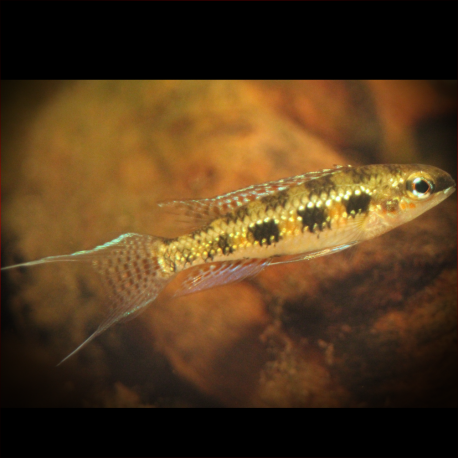More info
Datasheet
| Minimum Tank Size | 71 litres / 18.76 US gallons |
| Maximum Size | 10.2cm / 4.02inches |
| Temperature | 27°C / 80.60°F - 30°C / 86.00°F |
| Hardness | 0-1ºdH |
| pH | 4.5-7.0 |
General Description
Dicrossus Filamentosa, commonly known as Lyretail Checkerboard Cichlid, were initially categorized under the Crenicara genus but now fall under the Dicrossus genus along with Dicrossus Maculata. These cichlids are characterized by their lyretailed caudal fins, with Filamentosa distinct for this feature. They can be challenging to find in local fish stores and are considered a breeding challenge, but many breeders have achieved success. Notably, reports suggest that their eggs require a pH higher than 5.8 to hatch.
Aquarium Setup
Creating an accommodating environment for Checkerboard Cichlids involves a well-planted tank with ample hiding spots. These shy fish prefer to stay near the tank bottom amid plants and scattered leaves. Supplementing with floating plants and maintaining dim lighting can further enhance their habitat. Water conditions necessitate a pH range of 4.5-7.0, very soft water with minimal hardness (0-1 dH), and temperatures between 27-30°C. A tank size of at least 71 litres is recommended.
Behaviour
Lyretail Checkerboard Cichlids are relatively peaceful within their species but may struggle when housed with more aggressive tankmates. They thrive in community setups with other peaceful fish species due to their mild temperament.
Feeding and Diet
Checkerboards generally accept dry foods, particularly sinking cichlid pellets. It's crucial to provide a varied diet, including vegetarian or spirulina flakes and plenty of frozen foods. Live foods are highly recommended to induce breeding conditions; a daphnia culture is especially beneficial for this purpose.
Reproduction & Dimorphism
Breeding Dicrossus Filamentosa can be relatively straightforward with premium water conditions, requiring acidic water for successful reproduction. Males exhibit slightly larger size and possess the striking lyretailed caudal fin, while females are smaller, less colorful, and feature a rounded caudal fin.
Habitat and Distribution
Found in regions spanning Colombia, Venezuela, and parts of Brazil, Dicrossus Filamentosa inhabits water bodies from the Rio Inírida to Maripa and the Rio Orinoco, including sections of the Brazilian Rio Negro. Their habitats typically include soft, acidic waters rich in aquatic vegetation.

